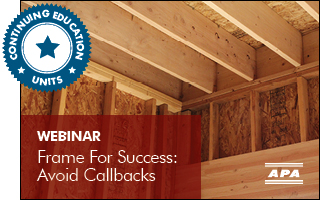Spring 2020

Highlights from this Month's e-Newsletter
Feature
Engineered Wood Construction Guide
The authoritative guide to building engineered wood floors, walls and roofs
 APA's Engineered Wood Construction Guide, Form E30, is the authoritative guide to building engineered wood floors, walls and roofs. Updated earlier this year, the 100-page reference manual features information on engineered wood products, recommendations for their use in residential and commercial construction and guidance on proper specification practices.
APA's Engineered Wood Construction Guide, Form E30, is the authoritative guide to building engineered wood floors, walls and roofs. Updated earlier this year, the 100-page reference manual features information on engineered wood products, recommendations for their use in residential and commercial construction and guidance on proper specification practices.
The guide is available at no charge when downloaded from the website (note: due to Covid-19 control measures, no print copies are being shipped at this time).
Building with engineered wood offers dependable performance, design flexibility, low in-place cost, sustainability and resilience. Engineered wood products are designed and manufactured to maximize the natural strength and stiffness characteristics of wood by optimally orienting the wood veneers, strands or laminations and by combining wood with durable structural adhesives. The resulting products are well suited for a wide range of applications and design needs, including wind and fire resistance, diaphragms and shear walls, noise control, energy efficiency, concrete forming and others.
GET >
Getting Technical
Upcoming Webinar: Frame for Success, Avoid Callbacks
June 4, 2020, 10–11:00 am Pacific
 Based on hundreds of job site inspections, APA staff have identified the most common wood construction framing and sheathing errors found in today’s construction market. This session will examine the consequences of these common errors and provide practical solutions for avoiding them. This course is approved by AIA (1 LU/HSW) and ICC (0.10 CEU). REGISTER >
Based on hundreds of job site inspections, APA staff have identified the most common wood construction framing and sheathing errors found in today’s construction market. This session will examine the consequences of these common errors and provide practical solutions for avoiding them. This course is approved by AIA (1 LU/HSW) and ICC (0.10 CEU). REGISTER >
Inside the Circle
 Meet Stephanie Thomas-Rees
Meet Stephanie Thomas-Rees
Stephanie is an Engineered Wood Specialist at APA – The Engineered Wood Association. From her location in Central Florida, Stephanie consults with builders, designers, code officials and suppliers on using engineered wood products efficiently and cost effectively. Stephanie is an experienced designer and energy professional with a bachelor’s degree in architectural design from Clemson University and a master’s degree in energy efficient building from Oxford Brookes University. As a building science professional, Stephanie’s past roles include project architect, designated energy efficiency coordinator, code coordinator and adjunct professor teaching sustainable design and building materials.
Archived Newsletters
Winter 2020 GO >
Autumn 2019 GO >
Summer 2019 GO >
Spring 2019 GO >
Winter 2019 GO >
Summer 2018 GO >
Spring 2018 GO >
Autumn 2018 GO >